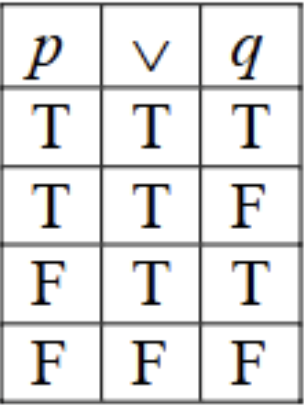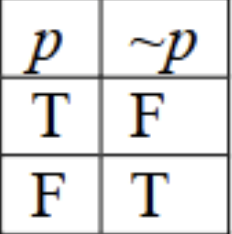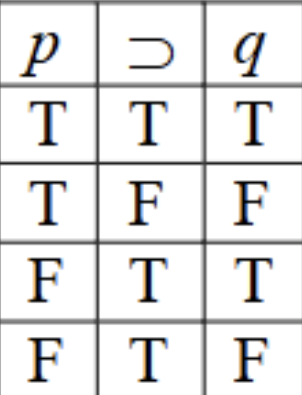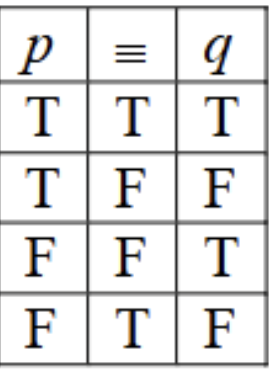Chapter 8 Notes: Truth Tables (Symbolic Logic)
1/41
There's no tags or description
Looks like no tags are added yet.
Name | Mastery | Learn | Test | Matching | Spaced |
|---|
No study sessions yet.
42 Terms
truth functions
the truth value of any compound statement (in propositional logic) is a function of the truth values assigned to its SIMPLE COMPONENTS
simple components
the simple statements within the compound statements
main operator
The truth value can be assigned to the _____ of more complex statements if you know the truth value of its simple constituents.
truth table
a table that shows us the TRUTH VALUE of a compound statement under EVERY POSSIBLE ASSIGNMENT of TRUTH VALUES to the SIMPLE COMPONENT
truth table definition of a conjunction

truth table definition of a disjunction

truth table definition of a negation

truth table definition of a conditional

truth table definition of a biconditional

List the premises and the conclusion in one horizontal line (conclusion on the far right).
Separate the premises from the conclusion with a double slash.
Determine the number of rows by using 2n, where n is the number of different letters in the symbolized argument.
Start filling in truth values under each letter.
Divide the TOTAL number of lines in half. Then go to the LEFTMOST LETTER and fill in that number of Ts and then that number of Fs. Do this every time you see this letter.
Divide the number you just used in half again, go to the next leftmost letter and fill in that number of Ts and number of Fs. Do this everywhere you see that letter.
Continue until your last letter; you’re alternating T, F, T, F all the way down the table everywhere you see that letter.
Fill in the truth values for the operators IN EACH PREMISE and for the CONCLUSION using truth table definitions. If the statement is COMPOUND, you will fill in the main operator last.
Check to see whether there’s any line on which the truth value under the main operator (or letter) of EACH PREMISE is T and the truth value under the main operator (or letter) of the CONCLUSION is false.
If there IS such a line, the argument is INVALID.
If there IS NOT such a line, the argument is VALID.
Steps for testing arguments with truth tables:
double slash
What do we use to separate the premises from the conclusion in a truth table?
single slash
What do we use to separate the premises from each other in a truth table?
2n, where n = the number of DIFFERENT letters in symbolized argument
How do you determine the number of rows in a truth table?
Divide the TOTAL number of lines in half. Then go to the LEFTMOST LETTER and fill in that number of Ts and then that number of Fs. Do this every time you see this letter.
Divide the number you just used in half again, go to the next leftmost letter and fill in that number of Ts and number of Fs. Do this everywhere you see that letter.
Continue until your last letter; you’re alternating T, F, T, F all the way down the table everywhere you see that letter.
How do you determine the truth values of the letters in truth tables?
indirect truth table
shortcut to direct truth tables that involves:
Assigning the value “T” to the MAIN OPERATOR of EVERY PREMISE
Assigning the value “F” to the MAIN OPERATOR of the CONCLUSION
Filling in the rest of the values for the letters and operators
If an argument is VALID, trying to make the premises true and conclusion false should result in a CONTRADICTION
No contradiction = INVALID
contradiction (indirect truth tables)
assigning T and F to the same simple statement at different places (indirect truth tables)
Tautalogous
Self-contradiction
Contingent
3 types of classifying statements
tautalogous
a compound statement that turns out to be TRUE NO MATTER WHAT TRUTH VALUES are assigned to its SIMPLE COMPONENTS
the value under the statement’s main operatoris TRUE on EVERY LINE
truth table terms for tautalogous statements
self-contradictory
a statement that turns out to be FALSE NO MATTER WHAT TRUTH VALUES are assigned to the SIMPLE COMPONENTS
the value under the statement’s main operator is FALSE on EVERY line
truth table terms for self-contradictory statements
contingent
a statement that is TRUE under AT LEAST ONE assignment of truth values to its SIMPLE COMPONENTS AND it’s FALSE under AT LEAST ONE
the value under the main operator (or single letter) is TRUE on AT LEAST ONE line AND FALSE on AT LEAST ONE
truth table terms for a contingent statement
Fill in the column under the statement’s MAIN OPERATOR LAST
Fill in the values under other operators (after letters) depending on what are the main operators of other parts of the statement
The order to follow when filling out a truth table (compound statements)
Logically Equivalent
Contradictory
Consistent
Inconsistent
Four Relations
logically equivalent
a type of relation in which two statements NECESSARILY have the SAME TRUTH VALUE
same truth value under the main operators on every line
truth table terms for logically equivalent relation
contradictory
a type of relation in which two statements NECESSARILY have OPPOSITE truth values
opposite truth values on every line under their main operators
truth table terms for a contradictory relation
consistent
a type of relation in which it’s POSSIBLE for both statements to be TRUE at the SAME TIME
on AT LEAST ONE line, the value TRUE appears under the main operator of BOTH STATEMENTS
truth table terms for a consistent relation
inconsistent
a type of relation in which it’s IMPOSSIBLE for both statements to be TRUE at the SAME TIME
NO LINE on which TRUE appears under the main operator of BOTH STATEMENTS
truth table terms for inconsistent relation
TWO statements CONTRADICT, ONE statement can be SELF-CONTRADICTORY
How are contradiction and self-contradiction different?
True
statements can have more than one of these relations to each other
True or False: the 4 relations we defined are NOT mutually exclusive
inconsistent
Any statements that contradict each other must also be _______
False
Statements CAN be logically equivalent to each other without stating the same information in two different ways.
True or False: Statements can only be logically equivalent if they restate the same information in two different ways.
logically equivalent
All tautologies are ________ ______ even though they don’t all state the same thing.
self-contradictory
All __________ statements are logically equivalent to one another.
strongest
Statements with multiple relations are usually classified by the _________ relation.
logically equivalent statements
If two statements are logically equivalent adn consistent, they are classified as
contradictory statements
If two statements are contradictory and inconsistent, they are classified as